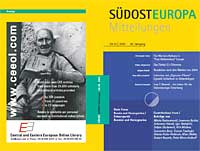Die „Dritte Wende" - Rumänien nach den Wahlen von 2004
The „Third Turning Point“ – Romania after the Elections in 2004
Author(s): Jürgen HenkelSubject(s): Politics / Political Sciences
Published by: Südosteuropa Gesellschaft e.V.
Summary/Abstract: In 2004, the presidential and parliamentary elections took place in Romania. “The Social Democratic Party” (PSD), governing until that date, had to give its power to the “Alliance for Justice and Truth” (D.A.), made up of the parties present in the opposition until that date – the “National Liberal Party” (PNL) and the “Democratic Party” (PD). Especially the increase in the population’s dissatisfaction with respect to overlapping economic and political interests between the governing and the economic circles in their political environment, the high level of poverty of large layers of the population, as well as the arrogant attitude of PSD politicians have led to this result. The mayor of Bucharest until then, Traian Băsescu, has ensured for himself the position of President in the second election tour and pushed the PSD candidate – Adrian Năstase, so far Prime Minister and President of the PSD – in the second place. A coalition has been made up of the PNL and PD parties, of the “Romanian Humanist Party” (PUR, a former ally of the PSD), of the “Democratic Union of the Hungarians in Romania” (UDMR) and of different deputies of the national minorities, the coalition being led by the President of the PNL, Călin Popescu Tăriceanu. The article analyzes the elections from the perspective of the political evolution of the last governing period between 2000 and 2004 and describes the formation of the government, as well as the political events in Romania in 2005.
Journal: Südosteuropa Mitteilungen
- Issue Year: 2005
- Issue No: 04-05
- Page Range: 24-42
- Page Count: 19
- Language: German
- Content File-PDF

